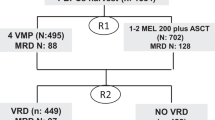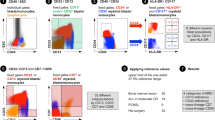Abstract
In acute myeloid leukemia (AML), assessment of minimal residual disease (MRD) by flow cytometry (flow MRD) after induction and consolidation therapy has been shown to provide independent prognostic information. However, data on the value of earlier flow MRD assessment are lacking. Therefore, the value of flow MRD detection was determined during aplasia in 178 patients achieving complete remission after treatment according to AMLCG (AML Cooperative Group) induction protocols. Flow MRD positivity during aplasia predicted poor outcome (5-year relapse-free survival (RFS) 16% vs 43%, P<0.001) independently from age and cytogenetic risk group (hazard ratio for MRD positivity 1.71; P=0.009). Importantly, the prognosis of patients without detectable MRD was neither impacted by morphological blast count during aplasia nor by MRD status postinduction. Early flow MRD was also evaluated in the context of existing risk factors. Flow MRD was prognostic within the intermediate cytogenetic risk group (5-year RFS 15% vs 37%, P=0.016) as well as for patients with normal karyotype and NPM1 mutations (5-year RFS 13% vs 49%, P=0.02) or FLT3-ITD (3-year RFS rates 9% vs 44%, P=0.016). Early flow MRD assessment can improve current risk stratification approaches by prediction of RFS in AML and might facilitate adaptation of postremission therapy for patients at high risk of relapse.
This is a preview of subscription content, access via your institution
Access options
Subscribe to this journal
Receive 12 print issues and online access
$259.00 per year
only $21.58 per issue
Buy this article
- Purchase on Springer Link
- Instant access to full article PDF
Prices may be subject to local taxes which are calculated during checkout





Similar content being viewed by others
References
Burnett A, Wetzler M, Löwenberg B . Therapeutic advances in acute myeloid leukemia. J Clin Oncol 2011; 29: 487–494.
Röllig C, Bornhäuser M, Thiede C, Taube F, Kramer M, Mohr B et al. Long-term prognosis of acute myeloid leukemia according to the new genetic risk classification of the European LeukemiaNet recommendations: evaluation of the proposed reporting system. J Clin Oncol 2011; 29: 2758–2765.
Döhner H, Estey EH, Amadori S, Appelbaum FR, Büchner T, Burnett AK et al. Diagnosis and management of acute myeloid leukemia in adults: recommendations from an international expert panel, on behalf of the European LeukemiaNet. Blood 2010; 115: 453–474.
NCCN Clinical Practice Guidelines in Oncology (NCCN Guidelines(R)) Acute Myeloid Leukemia [Internet]. nccn.org. 2012 [cited 30 September 2013]. Available from: http://www.nccn.org/professionals/physician_gls/pdf/aml.pdf.
Ofran Y, Rowe JM . Induction and postremission strategies in acute myeloid leukemia: what is new? Curr Opin Hematol 2011; 18: 83–88.
Rowe JM, Tallman MS . How I treat acute myeloid leukemia. Blood 2010; 116: 3147–3156.
Buccisano F, Maurillo L, Del Principe MI, Del Poeta G, Sconocchia G, Coco Lo F et al. Prognostic and therapeutic implications of minimal residual disease detection in acute myeloid leukemia. Blood 2012; 119: 332–341.
Buccisano F, Maurillo L, Spagnoli A, Del Principe MI, Fraboni D, Panetta P et al. Cytogenetic and molecular diagnostic characterization combined to postconsolidation minimal residual disease assessment by flow cytometry improves risk stratification in adult acute myeloid leukemia. Blood 2010; 116: 2295–2303.
Al-Mawali A, Gillis D, Lewis I . The role of multiparameter flow cytometry for detection of minimal residual disease in acute myeloid leukemia. Am J Clin Pathol 2008; 131: 16–26.
Rubnitz JE, Inaba H, Dahl G, Ribeiro RC, Bowman WP, Taub J et al. Minimal residual disease-directed therapy for childhood acutemyeloid leukaemia: results of the AML02 multicentre trial. Lancet Oncol 2010; 11: 543–552.
Kronke J, Schlenk RF, Jensen KO, Tschurtz F, Corbacioglu A, Gaidzik VI et al. Monitoring of minimal residual disease in NPM1-mutated acute myeloid leukemia: a study from the German-Austrian Acute Myeloid Leukemia Study Group. J Clin Oncol 2011; 29: 2709–2716.
Freeman SD, Virgo P, Couzens S, Grimwade D, Russell N, Hills RK et al. Prognostic relevance of treatment response measured by flow cytometric residual disease detection in older patients with acute myeloid leukemia. J Clin Oncol 2013; 31: 4123–4131.
San Miguel JF, Martínez A, Macedo A, Vidriales MB, López-Berges C, González M et al. Immunophenotyping investigation of minimal residual disease is a useful approach for predicting relapse in acute myeloid leukemia patients. Blood 1997; 90: 2465–2470.
Venditti A, Buccisano F, Del Poeta G, Maurillo L, Tamburini A, Cox C et al. Level of minimal residual disease after consolidation therapy predicts outcome in acute myeloid leukemia. Blood 2000; 96: 3948–3952.
Kern W . Determination of relapse risk based on assessment of minimal residual disease during complete remission by multiparameter flow cytometry in unselected patients with acute myeloid leukemia. Blood 2004; 104: 3078–3085.
Terwijn M, van Putten WLJ, Kelder A, van der Velden VHJ, Brooimans RA, Pabst T et al. High prognostic impact of flow cytometric minimal residual disease detection in acute myeloid leukemia: data from the HOVON/SAKK AML 42A Study. J Clin Oncol 2013; 31: 3889–3897.
Kern W, Haferlach T, Schoch C, Loffler H, Gassmann W, Heinecke A et al. Early blast clearance by remission induction therapy is a major independent prognostic factor for both achievement of complete remission and long-term outcome in acute myeloid leukemia: data from the German AML Cooperative Group (AMLCG) 1992 Trial. Blood 2003; 101: 64–70.
Bertoli S, Bories P, Bene MC, Daliphard S, Lioure B, Pigneux A et al. Prognostic impact of day 15 blast clearance in risk-adapted remission induction chemotherapy for younger patients with acute myeloid leukemia: long term results of the multicenter prospective LAM-2001 trial by the GOELAMS study group. Haematologica 2013; 99: 46–53.
Inaba H, Coustan-Smith E, Cao X, Pounds SB, Shurtleff SA, Wang KY et al. Comparative analysis of different approaches to measure treatment response in acute myeloid leukemia. J Clin Oncol 2012; 30: 3625–3632.
Braess J, Spiekermann K, Staib P, Gruneisen A, Wörmann B, Ludwig WD et al. Dose-dense induction with sequential high-dose cytarabine and mitoxantone (S-HAM) and pegfilgrastim results in a high efficacy and a short duration of critical neutropenia in de novo acute myeloid leukemia: a pilot study of the AMLCG. Blood 2009; 113: 3903–3910.
Buchner T, Hiddemann W, Wörmann B, Löffler H, Gassmann W, Haferlach T et al. Double induction strategy for acute myeloid leukemia: the effect of high-dose cytarabine with mitoxantrone instead of standard-dose cytarabine with daunorubicin and 6-thioguanine: a randomized trial by the German AML Cooperative Group. Blood 1999; 93: 4116–4124.
Buchner T . Double induction containing either two courses or one course of high-dose cytarabine plus mitoxantrone and postremission therapy by either autologous stem-cell transplantation or by prolonged maintenance for acute myeloid leukemia. J Clin Oncol 2006; 24: 2480–2489.
Falini B, Mecucci C, Tiacci E, Alcalay M, Rosati R, Pasqualucci L et al. Cytoplasmic nucleophosmin in acute myelogenous leukemia with a normal karyotype. N Engl J Med 2005; 352: 254–266.
Benthaus T, Schneider F, Mellert G, Zellmeier E, Schneider S, Kakadia PM et al. Rapid and sensitive screening for CEBPA mutations in acute myeloid leukaemia. Br J Haematol 2008; 143: 230–239.
Dufour A, Schneider F, Metzeler KH, Hoster E, Schneider S, Zellmeier E et al. Acute myeloid leukemia with biallelic CEBPA gene mutations and normal karyotype represents a distinct genetic entity associated with a favorable clinical outcome. J Clin Oncol 2010; 28: 570–577.
Schnittger S, Kern W, Tschulik C, Weiss T, Dicker F, Falini B et al. Minimal residual disease levels assessed by NPM1 mutation-specific RQ-PCR provide important prognostic information in AML. Blood 2009; 114: 2220–2231.
Grimwade D, Hills RK, Moorman AV, Walker H, Goldstone AH, Chatters S et al. Refinement of cytogenetic classification in acute myeloid leukemia: determination of prognostic significance of rare recurring chromosomal abnormalities among 5876 younger adult patients treated in the United Kingdom Medical Research Council trials. Blood 2010; 116: 354–365.
Kern W, Danhauser-Riedl S, Ratei R, Schnittger S, Schoch C, Kolb H-J et al. Detection of minimal residual disease in unselected patients with acute myeloid leukemia using multiparameter flow cytometry for definition of leukemia-associated immunophenotypes and determination of their frequencies in normal bone marrow. Haematologica 2003; 88: 646–653.
Cheson BD, Bennett JM, Kopecky KJ, Büchner T, Willman CL, Estey EH et al. Revised recommendations of the International Working Group for Diagnosis, Standardization of Response Criteria, Treatment Outcomes, and Reporting Standards for Therapeutic Trials in Acute Myeloid Leukemia. J Clin Oncol 2003; 21: 4642–4649.
Loken MR, Alonzo TA, Pardo L, Gerbing RB, Raimondi SC, Hirsch BA et al. Residual disease detected by multidimensional flow cytometry signifies high relapse risk in patients with de novo acute myeloid leukemia: a report from Children's Oncology Group. Blood 2012; 120: 1581–1588.
Sievers EL . Immunophenotypic evidence of leukemia after induction therapy predicts relapse: results from a prospective Children's Cancer Group study of 252 patients with acute myeloid leukemia. Blood 2003; 101: 3398–3406.
Paietta E . Minimal residual disease in acute myeloid leukemia: coming of age. Hematology Am Soc Hematol Educ Program 2012; 2012: 35–42.
Paietta E . When it comes to MRD, AML≠ALL. Blood 2012; 120: 1536–1537.
Leung W, Pui CH, Coustan-Smith E, Yang J, Pei D, Gan K et al. Detectable minimal residual disease before hematopoietic cell transplantation is prognostic but does not preclude cure for children with very-high-risk leukemia. Blood 2012; 120: 468–472.
Basso G, Veltroni M, Valsecchi MG, Dworzak MN, Ratei R, Silvestri D et al. Risk of relapse of childhood acute lymphoblastic leukemia is predicted by flow cytometric measurement of residual disease on day 15 bone marrow. J Clin Oncol 2009; 27: 5168–5174.
Schrappe M . Minimal residual disease: optimal methods, timing, and clinical relevance for an individual patient. Hematology Am Soc Hematol Educ Program 2012; 2012: 137–142.
Terwijn M, Kelder A, Snel AN, Rutten AP, Scholten WJ, Oussoren YJM et al. Minimal residual disease detection defined as the malignant fraction of the total primitive stem cell compartment offers additional prognostic information in acute myeloid leukaemia. Int J Lab Hematol 2012; 34: 432–441.
Acknowledgements
We thank the participating centers of the AMLCG clinical trial. Furthermore, we also thank Elke Habben, Karin Hecht and Ewelina Zientara (Laboratory for Leukemia Diagnostics, University Hospital Munich, Munich, Germany) for their excellent technical support. This work was supported by the Deutsche Krebshilfe grant 109031. WH, KS and SKB received support from the Deutsche Forschungsgemeinschaft (SFB684, projects A6, A12).
Author contributions
TK, DS, KR and MH collected and analyzed the data; SKB, PMK and SS were responsible for genetic analyses; AD and KS performed assessment of NPM1; WEB, TB, BH, JB and WH coordinated the AMLCG clinical trial; RPL and EH provided advice for statistical analyses; TK and DS wrote the manuscript; KS aided in the supervision of the project; MS is head of the flow cytometry unit at the Laboratory of Leukemia Diagnostics and designed the research, interpreted the data and supervised the project.
Author information
Authors and Affiliations
Corresponding author
Ethics declarations
Competing interests
The authors declare no conflict of interest.
Additional information
Supplementary Information accompanies this paper on the Leukemia website
Supplementary information
Rights and permissions
About this article
Cite this article
Köhnke, T., Sauter, D., Ringel, K. et al. Early assessment of minimal residual disease in AML by flow cytometry during aplasia identifies patients at increased risk of relapse. Leukemia 29, 377–386 (2015). https://doi.org/10.1038/leu.2014.186
Received:
Revised:
Accepted:
Published:
Issue Date:
DOI: https://doi.org/10.1038/leu.2014.186
This article is cited by
-
Flow cytometric measurable residual disease in adult acute myeloid leukemia: a preliminary report from Eastern India
Journal of Hematopathology (2023)
-
Phase I study evaluating the Fc-optimized FLT3 antibody FLYSYN in AML patients with measurable residual disease
Journal of Hematology & Oncology (2023)
-
Reproducible measurable residual disease detection by multiparametric flow cytometry in acute myeloid leukemia
Leukemia (2022)
-
Association of hematologic response and assay sensitivity on the prognostic impact of measurable residual disease in acute myeloid leukemia: a systematic review and meta-analysis
Leukemia (2022)
-
In-silico comparison of two induction regimens (7 + 3 vs 7 + 3 plus additional bone marrow evaluation) in acute myeloid leukemia treatment
BMC Systems Biology (2019)



